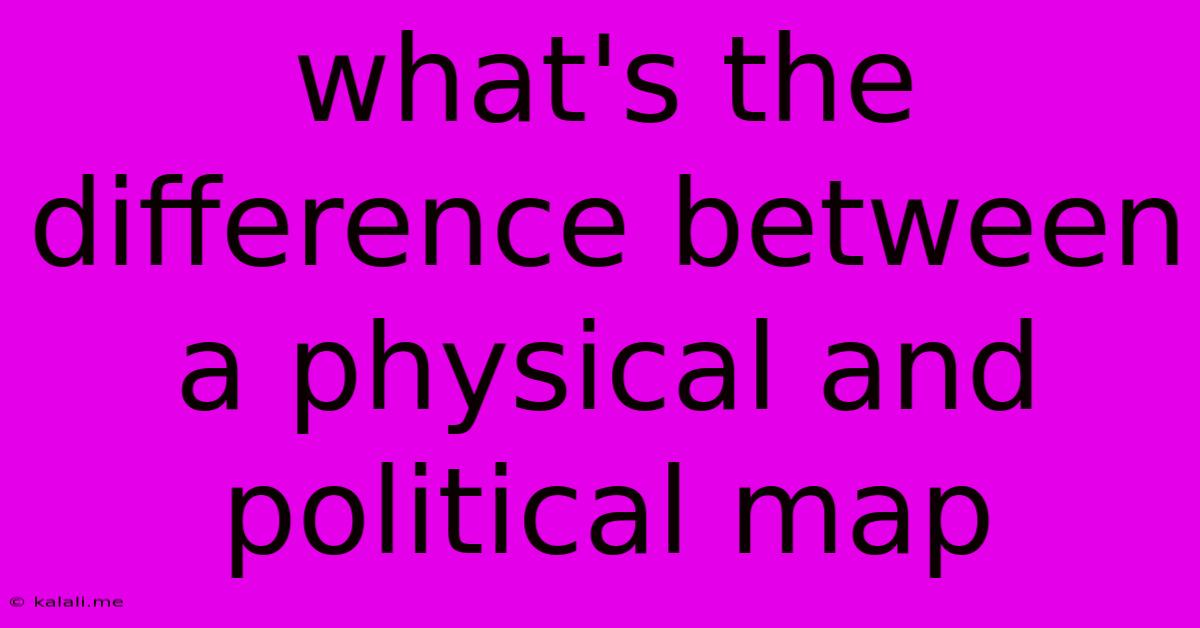What's The Difference Between A Physical And Political Map
Kalali
Jun 14, 2025 · 3 min read

Table of Contents
Delving into the Differences: Physical vs. Political Maps
Understanding the differences between physical and political maps is crucial for anyone needing to interpret geographical information effectively. While both types display geographical data, they focus on different aspects of the Earth's surface, employing distinct visual representations to convey their specific information. This article will clarify the key distinctions between these two fundamental map types, highlighting their unique purposes and applications. This will help you understand how to use each effectively and how to choose the right map for your specific needs.
What is a Physical Map?
A physical map primarily illustrates the Earth's natural features. Think mountains, valleys, rivers, oceans, deserts, and plains. These features are depicted using a variety of techniques, including:
- Contour lines: These lines connect points of equal elevation, helping to show the shape and slope of landforms. Understanding contour lines is vital for interpreting the three-dimensional nature of the terrain.
- Color-coding: Different colors are used to represent varying elevations, with greens often signifying lowlands, yellows representing plains and foothills, and browns and oranges depicting higher elevations like mountains. Water bodies are typically shown in blue.
- Relief shading: This technique uses shading to create a three-dimensional effect, enhancing the perception of mountains and valleys.
- Symbols: Standardized symbols represent specific features like forests, glaciers, and swamps.
The Purpose of Physical Maps:
The primary purpose of a physical map is to provide a visual representation of the Earth's topography and natural landscape. They're excellent for:
- Understanding terrain: Identifying mountains, rivers, and other landforms that may impact activities such as transportation, agriculture, or settlement.
- Geographical analysis: Analyzing the distribution of natural resources and their relationship to human activity.
- Environmental studies: Understanding the location and characteristics of different ecosystems and biomes.
- Planning and development: Assessing the suitability of land for various purposes, considering factors like elevation, slope, and proximity to water.
What is a Political Map?
A political map focuses on human-created boundaries and political divisions. This includes:
- National borders: The lines that delineate countries and territories.
- State and provincial boundaries: Subdivisions within countries.
- Cities and towns: Population centers marked by points or labeled locations.
- Capital cities: Often marked with a star or a different sized symbol.
- Major roads and transportation routes: Indicating infrastructure networks.
The Purpose of Political Maps:
The main goal of a political map is to display the organization of human-created political entities. They are vital for:
- Understanding political geography: Analyzing the spatial arrangement of countries, states, and other political units.
- Geopolitical analysis: Studying the relationships and interactions between countries and their territories.
- International relations: Examining boundaries, disputes, and alliances between nations.
- Travel and navigation: Locating cities, towns, and other places of interest.
- Understanding demographics: Showing population centers and the distribution of people.
Key Differences Summarized:
| Feature | Physical Map | Political Map |
|---|---|---|
| Focus | Earth's natural features | Human-created boundaries and political divisions |
| Content | Mountains, rivers, oceans, etc. | Countries, states, cities, etc. |
| Visuals | Contour lines, color-coding, relief shading | Lines, labels, symbols |
| Purpose | Display terrain and natural landscape | Display political organization and boundaries |
Conclusion:
Both physical and political maps are essential tools for understanding the Earth and its complexities. While distinct in their focus and representation, they are often complementary, with many maps incorporating elements of both to provide a more comprehensive view of a particular region. Understanding the differences between these map types allows for effective interpretation and application of geographical information in various contexts.
Latest Posts
Latest Posts
-
Which Of The Following Is True About Rocks And Minerals
Jun 14, 2025
-
Least Common Multiple Of 8 12 15
Jun 14, 2025
-
How Many Electrons Does Oxygen Have In Its Outermost Shell
Jun 14, 2025
-
Best Words To Describe Your Mom
Jun 14, 2025
-
What Is The Root Of 289
Jun 14, 2025
Related Post
Thank you for visiting our website which covers about What's The Difference Between A Physical And Political Map . We hope the information provided has been useful to you. Feel free to contact us if you have any questions or need further assistance. See you next time and don't miss to bookmark.